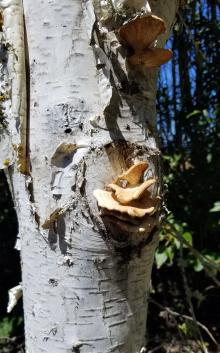Cause Two types of wood decay occur in living trees: white rots and brown rots. The more common fungal white rots in birch are caused by Ganoderma applanatus, Fomes fomentarius, and Phellinus igniarus. White rots cause all major structural components of the cell wall-cellulose, hemicellulose, and lignin-to degrade. The strength of white rotted wood decreases only in advanced stages of decay. Infection occurs through branch stubs and wounds. Conks usually develop in these same areas.
The more common fungal brown rots in birch are caused by Piptoporus betulinus (brown cubical rot) and Stereum ostrea (brown crumbly rot). Brown rots cause most of the cell wall polysaccharides to degrade, but the lignin component is unchanged or slightly modified. The strength of brown rotted wood is significantly reduced or lost entirely shortly after decay begins. These rots usually are in exposed wood and can cause extensive damage, resulting in structural failure.
Injuries from pruning cuts, sunburn, or storm damage can expose susceptible wood as well as damage from the Bronze birch borer. Large wounds and stubs, and horizontal cuts are often entry sites for decay fungi. Wood decay generally is observed in older trees after extensive fungal colonization. Decay fungi frequently function as secondary invaders following a succession of microorganisms, including bacteria, yeasts, and other fungi. Decay in a single tree may be caused by more than one fungal species. Live trees are able to limit wood decay by walling off and compartmentalizing decay fungi but this can vary between different species and individuals. The CODIT model/principle (compartmentalization of decay in trees) is used by certified arborists to manage landscape trees with decay.
Symptoms White rots cause moist, soft, or spongy wood that is a lighter color than sound wood. Fine black lines may run throughout the decayed area. The conks of Fomes fomentarius are perennial and hoof shaped. The upper surface is smooth, gray to grayish brown, and concentrically zoned. The under surface is brown with small circular pores. The interior of the conk is dark brown and the tubes (pores) appear extremely long; annual layers not being conspicuous as in many other perennial conks. The tubes are often encrusted with white material. The conks of Phellinus igniarus are also hard, woody, and usually hoof shaped. The upper surface of young conks is grayish black and smooth, but with age this surface becomes rough and cracked.
Brown rots of wood are brown, dry, and crumbly, with longitudinal and transverse cracks. These rots usually are in exposed wood and can cause extensive damage, resulting in structural failure. For Piptoporus betulinus the decayed wood is yellowish-brown and usually cracked, with thin white sheets composed of fungus mycelium in the cracks. The wood is light in weight and powders easily under pressure. The conks are annual, corky, and either shelf or hoof shaped. The upper surface is smooth and gray. The outer margin curves inward toward the under surface. The lower surface is yellowish-white when fresh, becoming brown with age and is composed of small pores. The pore layer breaks away easily from the rest of the conk. The annual fruiting bodies of Stereum ostrea are thin, leathery, shelf-like brackets, one above another. The upper surface is buff colored, but becomes gray with age. The under surface is light brown and smooth.
Each of these wood decays leads to limb breakage and/or uprooted trees during wind or ice storms. Many trees have decreased vigor and dieback.
Cultural control
- Avoid wounding trees to prevent decay. For example, mowing equipment should not injure the roots, crown, or lower trunk.
- Make pruning cuts adjacent to, but not into, the supporting branch, and prune when branches are small to enhance callus formation and wound healing.
- Irrigation water, especially from sprinklers, should not wet the trunks.
- Inspect trees for decay and/or conks to assess tree stability.
- Remove affected trees to avoid damage to surrounding property or spread to other trees.
References Shaw, C.G., and Harris, M.R. 1960. Important diseases and decays of trees native to Washington. Ag Extension Service, WSU. Extension Bulletin 540.


